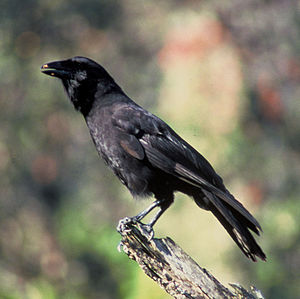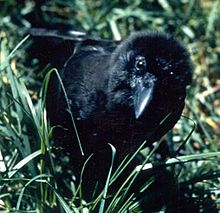Hawaiian crow
| Hawaiian crow | ||||||||||||
|---|---|---|---|---|---|---|---|---|---|---|---|---|

Hawaiian crow ( Corvus hawaiiensis ) |
||||||||||||
| Systematics | ||||||||||||
|
||||||||||||
| Scientific name | ||||||||||||
| Corvus hawaiiensis | ||||||||||||
| Peale , 1848 |
The Hawaiian Crow ( Corvus hawaiiensis ), in the Hawaiian language as 'Alala referred to is an extremely rare bird art that exists only in captivity in Hawai'i.
Origin of name and description
The name ʻAlala means on the one hand "to scream like a small animal". Indeed, the call of this crow is reminiscent of the cry of a young child. On the other hand, it means “to wake up with the sun”. This has to do with the fact that their loud, piercing screams can be heard at dawn. This bird reaches a size of 48 centimeters. The entire body is sooty black. Only the wings are a little paler in color. The eyes are brown. The young birds have blue eyes.
Way of life
The Hawaiian crow is an omnivore. It feeds on fruits, carrion, eggs, nestlings and waste, as well as insects that it finds in the bark. Both parents take part in building the nest. Five eggs are usually laid and incubated by one parent while the other sits quietly next to the partner.
Like the New Caledonia crows, the birds use suitable sticks as tools and use them skillfully to fetch food from holes and crevices. Young crows that do not have the opportunity to learn it from adult birds also develop this ability.
Danger
The decline of this species began around 1890 with the appearance of white farmers in Hawaii. 'Alala used to be widespread in all the Hawaiian Islands, but from 1891 it was viewed as a plague and ruthlessly persecuted. The farmers imitated their cry, which was considered the loudest bird cry in the forests of Kona . When the birds were attracted close enough, they were shot down. At the beginning of the 20th century, the once large 'Alala swarms had disappeared. It originally fed on the berries of the Ieie vine ( Freycinetia arborea ), the Ohelo berry (also known as the Hawaiian craneberry , Vaccinium reticulatum ) or other fruits from the forests, but after the original koa acacias had to make way for introduced plant species , changed the way of life of the ʻAlala. Introduced animal species such as the golden mongoose ( Herpestes auropunctatus ) as well as changes in the food supply and bird diseases led to a further dramatic decline. In 1973 the Hawaiian crow was placed under conservation. In 1996 there were only 14 specimens left in the wild and in 1999 only three. In 2002 the last two birds disappeared from their breeding grounds in the "Hakalau National Wildlife Refuge". So she was considered extinct in the wild. From the 1970s, the Hawaiian crow was also bred in human care. In 1996 there were 15 specimens in captivity. In 1998 a company failed to release 24 specimens. Since the bred animals were unable to defend themselves against the new enemies such as the Hawaiian buzzard ( Buteo solitarius ) and the introduced bird malaria, 18 animals were killed. The six surviving animals were recaptured. In 2009 56 birds lived in two rearing stations. In the same year, the US Fish and Wildlife Service announced it would invest $ 14 million in a conservation project, primarily to protect habitats and eliminate possible threats to wild crows. By 2016 the population increased to 131 individuals.
literature
- Steve Madge & John Marzluff : Family Corvidae (Crows and Allies) In: Del Hoyo et al. (2009): Handbook of the Birds of World Volume 14, ISBN 978-84-96553-50-7
- Walters, Mark Jerome (2006): Seeking the Sacred Raven: Politics and Extinction on a Hawaiian Island , Island Press , ISBN 1-55963-090-6
Web links
- Description of the Hawaiian Crow (English)
- BirdLife factsheet - Corvus hawaiiensis (English)
- US Fish and Wildlife Service - Draft Recovery Plan for the Hawaiian Crow (2003) (English; PDF, 859 kB)
- Corvus hawaiiensis inthe IUCN Red List of Threatened Species 2016.2. Listed by: BirdLife International, 2013. Retrieved September 9, 2016.
- Videos, photos and sound recordings of Corvus hawaiiensis in the Internet Bird Collection
Individual evidence
- ↑ Christian Rutz, Barbara C. Klump, Lisa Komarczyk, Rosanna Leighton, Joshua Kramer, Saskia Wischnewski, Shoko Sugasawa, Michael B. Morrissey, Richard James, James JH St Clair, Richard A. Switzer & Bryce M. Masuda: Discovery of species -wide tool use in the Hawaiian crow. In: Nature . Volume 537, No. 7620, 2016, pp. 403–407, doi: 10.1038 / nature19103 , illustration of a bird with a stick on the cover of Nature
- ↑ Rare crow shows a talent for tool use Nature Video on Youtube
- ↑ $ 14 M effort announced to save rare Hawaiian bird
